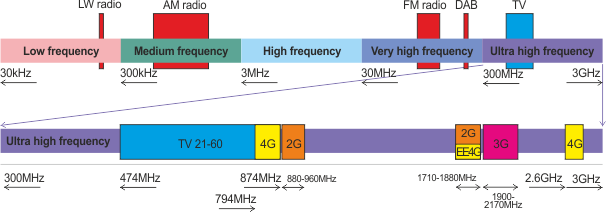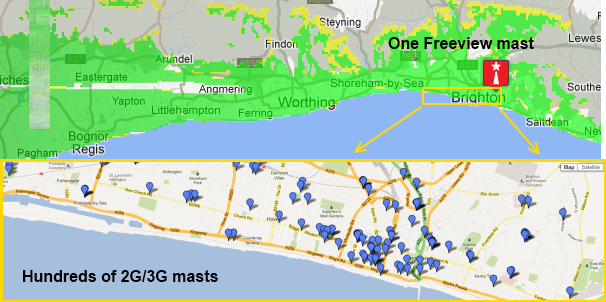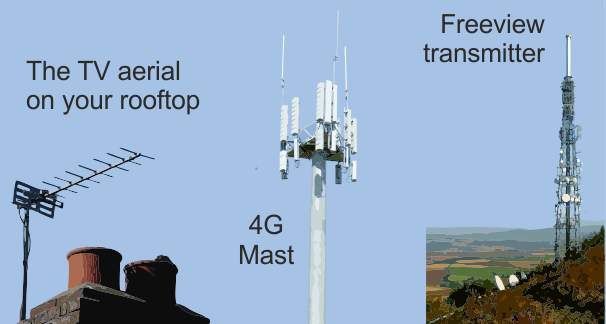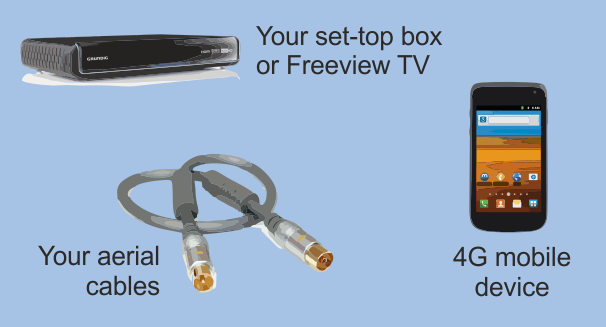How do I know if the 4G broadband will overload my Freeview?
 Brian Butterworth published on UK Free TV
Brian Butterworth published on UK Free TV Back in June 2011, we looked at how Ofcom moves to protect Freeview interference from 4G mobile .
Since then, the television Digital Switchover has been finished and 4th generation (4G) mobile broadband services - also known as Long Term Evoluition (LTE) have launched all over the world, including a service from Everything Everywhere (EE) in the UK.
To understand why and how these 4G broadband services will cause problems during 2013, you need to take into consideration a number of technical factors.
Understanding the radio spectrum
The Radio spectrum is the name given to the frequencies of the electromagnetic spectrum that can be usefully used to transmit radio, television and data services.The top bar on the diagram below (or download) shows a selection of the services used in the UK, with old-fashioned long-wave radio, then medium-wave radio, though FM radio, the digital DAB radio services up to those used for television broadcasting. (See here for a really complex chart).

The highest frequencies on the diagram, the "ultra high frequencies" (or UHF) band is shown enlarged as the lower purple bar. In this range we can see TV "channels C21 to C60" (blue), second- and third- generation mobile phones (2G orange, 3G pink) and the location for the 4G services.
It is important to note that some of the 2G capacity in the "1800MHz" range has already been converted to 4G operation by Everything Everywhere (EE). The other two yellow boxes show the "800MHz" (to the left) "2.6GHz" (on the right).
For the purpose of Freeview reception, only the 800MHz range need be considered. The other two ranges will not cause Freeview problems.
Protecting Freeview receivers against overload
As we have seen already - Freeview signals: too much of a good thing is bad for you - Freeview boxes are designed to protect themselves against signal overloads. When they do this they close down and people often incorrectly diagnose the problem as being "no signal" when there is too much.The problem that has to be solved as the 4G services launch, is that the new mobile broadband signals can cause overloads onto the frequencies that are being used for Freeview.
 One particular problem is that a very common type of Freeview signal decoder, a superheterodyne receivers are sensitive to signals being present nine channels (72MHz) away.
One particular problem is that a very common type of Freeview signal decoder, a superheterodyne receivers are sensitive to signals being present nine channels (72MHz) away.
In addition to overloads, 4G may also cause Signal-Interference Noise Ratio degradation, where reception breaks down because the receiver can no longer decode the digital information in the transmission.
Knowing who will win the 4G auction
 Until the
4G auction takes place, no one will know which company has the right to use the 800MHz channels for mobile devices. The following companies have qualified to bid:
Until the
4G auction takes place, no one will know which company has the right to use the 800MHz channels for mobile devices. The following companies have qualified to bid:
- Everything Everywhere Limited (UK)
- HKT (UK) Company Limited (a subsidiary of PCCW Limited)
- Hutchison 3G UK Limited
- MLL Telecom Ltd
- Niche Spectrum Ventures Limited (a subsidiary of BT Group plc)
- Telefonica UK Limited
- Vodafone Limited
Viewing high power television and using low power mobiles
Using the 'Sitefinder' Mobile Phone Base Station Database you can compare the locations of existing mobile phone "masts" with those used for Freeview Transmitters. Here is an example from Brighton and Hove, where a medium-sized single mast (Whitehawk Hill) can cover a whole city, but where hundreds of mobile phone base-stations cover a many smaller-by-comparison areas.
This illustrates two points. Firstly, that Freeview broadcasts are high powered and one-to-many - mobile devices are low power and peer-to-peer. The mast your TV signal comes from may be miles, sometimes tens or miles away, for your mobile perhaps only meters away.
The second point is that if an existing 2G/3G mobile supplier wins a 800MHz 4G slot, they will wish to use their existing "phone mast" locations (especially the 900MHz ones) as this would be most economical for them. Until the action winners emerge, and then plan their network, only idle speculation about possible interference can be made.
Using the TV frequencies for 4G masts and phones
Research (see here) shows that a 4G mast in relative close proximity, or a mobile 4G handset closer than a meter to an unfiltered Freeview box will cause overloading on many tested devices. The following diagram shows the relationship between the 4G use and the old TV channel designations.
Those Freeview transmitters that use channels above C52 are most likely to have receivers that get overloaded by the use of 4G signals in the 800MHz area. FDD is Frequency-division duplexing - the transmitter and receiver operate at different carrier frequencies.
Interpreting the aerial and mast locations
Once the proposed mast locations for 4G services are known, it will then be possible to predict which homes will need to fit the special filters in areas where Freeview uses the higher channel numbers (the C52 to C60 range).
If you then have a rooftop aerial without a signal amplifier, to get an overload you will need the 4G mast to be in the line-of-sight between your Freeview transmitter and the aerial, or possibly "directly behind" the aerial.
If you then have a rooftop aerial and an amplifier, or perhaps have lower-grade cables, you are likely to need to protect from a 4G overload if the phone mast is close to your rooftop aerial.
Finding transmitters that use the higher range frequencies
Some powerful transmitters and many relays use the high frequencies: Sudbury, Oxford, Belmont, Winter Hill, Tacolneston, Pontop Pike, Mendip, Emley Moor, Clermont Carn, Truskmore and Maghera.Click below to find out the transmitters in with high frequency allocations:
- C60 is used by 126 transmitters - including Sudbury, Oxford, Belmont;
- C59 is used by 142 transmitters - including Winter Hill and Tacolneston;
- C58 is used by 100 transmitters - including Winter Hill, Sudbury, Pontop Pike and Mendip;
- C57 is used by 131 transmitters - including Clermont Carn, Truskmore, Oxford;
- C56 is used by 73 transmitters - including Mendip, Sudbury;
- C55 is used by 139 transmitters - including Maghera, Winter Hill and Tacolneston ;
- C54 is used by 104 transmitters - including Mendip, Pontop Pike and Winter Hill;
- C53 is used by 131 transmitters- including Truskmore, Belmont, Oxford;
- C52 is used by 81 transmitters - including Emley Moor, Sandy Heath, Clermont Carn and Mendip.
Protecting Freeview boxes and sets, cables, amplifiers from 4G devices
Again in areas where Freeview uses the higher channel numbers (C52 and above) you may have to protect your Freeview devices from signals from a 4G handset (such as mobile phone, tablet, or USB "dongle").
This may, once again, require the fitting of a special filter, or the upgrading of the "fly leads" used to connect your aerial to the set top box or TV. This may be a particular problem if you have used an indoor aerial or signal amplifier.
Help with TV/radio stations?
In this section
Sunday, 14 June 2015
R
rob1:48 PM
I have replaced the 5 year old mast head amplifier and PSU for a Triax 4 way 4 g filtered masthead amplifier i am happy to report that has cleared allot of my reception problems and free view signal is now stable no more break ups. I think the old mast head amp/PSU was on its way out as it was on for 5 years 24/7
| link to this comment |
J
jb388:30 PM
rob : Thanks for the update, pleased to know that you have succeeded in overcoming the problem.
However, I do have to say, that as far as your old mast head amplifier as well as the age of is concerned, they either work or they don't, never partially unless through internal corrosion caused by water ingress, and your success is more likely to be attributable to the 4G filter incorporated within the new amplifier rather than anything else.
Although you cant go wrong by updating / replacing your old masthead amp.
| link to this comment |
Friday, 26 June 2015
M
mike gailer8:56 PM
All was OK with my Freeview TV until last night about 10pm Thursday 25th June 2015
and lost the picture and all sound etc and it froze. Cannot get any channel at all now
even as at Friday night . It attempts to get a picture but it is very very fragmented
and no sound because of that I guess. Not one channel.
Any ideas what has caused the sudden failure (weather maybe ) ?. Check cables and
all OK .
| link to this comment |
Monday, 27 July 2015
F
Frederica12:36 PM
London
Watching TV is becoming a nightmare as I never know if I will get to the end of a programme as we keep 'going off' sometimes all the BBC (at least I can watch BBC live on my desktop) sometimes ITC programs or Freeview, sometimes all. This has been relentless for the last month or so. I share a communal arial, and all leads are OK.
Is is 4G that is doing this? How do I find out? what can I do? I LIVE IN LONDON W11 4BT
Please help as is sending me MAD!!!!
Frederica 27th July 2015
| link to this comment |
Frederica's: mapF's Freeview map terrainF's terrain plot wavesF's frequency data F's Freeview Detailed Coverage
Tuesday, 28 July 2015
Hi Frederica
4G problems are quite rare although it is and can be a problem more than lightly its a system fault
First thing you need to investigate, are others on the same communal system having the same symtoms?
If the only one with problems and your sure your tuned into correct channel frequencys hook another TV up to the same outlet to prove its not or is your TV at fault.
IIf others also have a problem and your TV equipment is ok then you will need to contact the building management services that maintains your property to deal with it
Regards
Dave
| link to this comment |
Saturday, 5 August 2017
M
Marcia12:52 PM
I am in Thornbury South Glos. Bristol the 4 g mast is next to my house I did not know anything about interference and 4g masts and paid an aerial supplier 75 to put a filter on my aerial where my booster is. Although I now have channels back they break up on and off and sometimes viewing is impossible. Does this mean I am one of the people that need to view through freesat? If so how would I get this and who would I ask Thankyou Marcia
| link to this comment |
M
MikeB8:31 PM
Peterborough
Marcia: Firstly, if you did have a 4G mast next to your home, It's very surprising that you never got a postcard about 4G - even I got one, and my nearest mast was a couple of miles away. And you could have got a free 4G filter just by contacting A800.
Next, you havn't given a postcode, so we have no idea what your signal is like in relation to your transmitter, or which one it is. Do you need a booster? 4G hits higher frequencies in rural areas that have a weak signal strength, and are most likely to hit receivers that have boosters.
There could be a number of reasons why your TV signal is poor - your signal could be too strong, especially with a booster, or it could have a fault with the system itself - perhaps loose or waterlogged connections. The reality is that the vast bulk of people who've said they've had a problem with 4G are suffering from something else.
| link to this comment |
MikeB's: mapM's Freeview map terrainM's terrain plot wavesM's frequency data M's Freeview Detailed Coverage
Sunday, 6 August 2017
M
Michael Martin12:47 PM
For some time, on my Humax DVR TV Guide (on which I only have 15 channels) channel 24 - ITV4 (which I rarely watched) shows only "Quest Red+1 is back at ...". What does this mean? I can see that ITV4 is still there on my Panasonic TV..
| link to this comment |
Thursday, 23 July 2020
P
Philip Davies12:24 AM
Borth
Just received my at800 filter to deal with 4g interference that I suffer on one - and only one - Freeview Channel/Multiplex from Blaenplwyf. The thing is just a gimmick - it actually made my picture and sound on Channel 25 - all programs - even worse. All other Channels/Multiplexes are free from interference. Unfortunately they are also increasingly taken over by long advertising breaks every few minutes, and consist chiefly of repetitious recycling of the same old programmes. Everything was fine with reception until they allowed a complete free-for-all scramble for mobile phone services. I'm tired of having to constantly fiddle with Freeview to keep program sI already had, and having to put up with the random disappearance of others that used to come through with no problem. I've heard that even Freesat has its share of interference, so I'm not attracted to paying to have a dish and new equipment for that. Sky is far too expensive; I already have Netflix - whose catalogue is not as good as it used to be - and I don't have any more available sockets - or cash - for other streaming services. So increasingly I must watch on the small screen of an old PC with a very shaky video processor at low resolution. Thank goodness I can still rely on the radio and that completely reliable technology known as A BOOK ! And they call it progress !!
| link to this comment |
Philip's: mapP's Freeview map terrainP's terrain plot wavesP's frequency data P's Freeview Detailed Coverage
Select more comments
Your comment please!